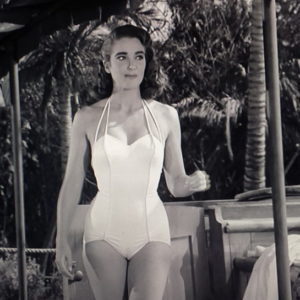When this year’s Academy Awards did the “In Memoriam” segment, its annual tribute to movie figures who died during the year, a number of deserving actors were omitted. Among them were two iconic actors from a legendary 1950s genre: science fiction/horror film.
Both died within a few days of each other, and each was a star of an enduring cult classic from the decade. By most standards, neither of their films was a great cinematic work, but both conveyed a bit of the cultural heritage of the misunderstood 1950s.
Julie Adams was the curvaceous heroine of the 1953 film “The Creature From the Black Lagoon.” The story is about an outcast monster, who is irresistibly and fatally attracted to a beautiful girl, a familiar meme in movies such as “King Kong” and in fairy tales such as “Beauty and the Beast.”
As the object of the creature’s desire, Julie Adams is unquestionably the highlight of the film, and the underwater scenes, where the creature tracks her as she swims, may have been the inspiration for Steven Spielberg and the opening scene from “Jaws.”
Like many of its 1950s sci-fi counterparts (“Godzilla,” “The Day the Earth Stood Still,” “The Invasion of the Body Snatchers”), “The Creature From the Black Lagoon” is a parable about man’s scientific arrogance in a post-Hiroshima world.
Several days after Julie Adams died, another actor featured in a 1950s horror classic died. Dick Miller played the hapless nebbish Walter Paisley in director Roger Corman’s “A Bucket of Blood,” a prelude to Corman’s better-known film “Little Shop of Horrors.”
Made in less than a week with an estimated budget of $50,000, “A Bucket of Blood” is as much a comedy as it is a horror film; it satirizes 1950s’ concerns: beatniks, fame, artistic pretension, drugs, sex and violence.
Walter Paisley (a character name Dick Miller used in many subsequent films) goes from a nobody to “the next big thing” — but he must become a gruesome murderer in the process.
Ask most people what their impressions are of America of that era and words such as suburbia, conformist, white privilege, boring likely come to mind, especially from people born after that decade or too young to remember it. It was, after all, the decade of the Eisenhower presidency, Debbie Reynolds, Peyton Place, Perry Como and “Father Knows Best.”
In reality, the 1950s were a complex, vibrant decade. While much of America was still steeped in Jim Crow racism, it was the decade of the most important Supreme Court decision of the 20th century, Brown v. Board of Education — the first step in desegregating schools across the country. Jackie Robinson broke baseball’s color barrier in the 1940s, but he starred athletically in the 1950s, and virtually every team in the three major professional sports was integrated by the end of the decade.
Pursuant to President Harry Truman’s 1948 executive order desegregating the military, the Army had integrated more than 90 percent of black troops in its ranks by the end of 1953.
Musically, it was the decade of Elvis. His music, along with that of artists like Chuck Berry, Bill Haley, Fats Domino and others, gave birth to rock and roll. Rhythm and blues flourished and Motown was born. It was Frank Sinatra’s finest decade, and probably the greatest decade for folk music and jazz. The 1956 Newport Jazz Festival featuring Duke Ellington remains a legendary event in American music.
In the literary world, Jack Kerouac and Alan Ginsburg came of age in the 1950s, as did Sylvia Plath, J.D. Salinger, Vladimir Nabokov, Arthur Miller, Hugh Hefner, Lorraine Hansberry, Ralph Ellison and James Baldwin. Some of the books published during the decade included “The Catcher in the Rye,” “The Lord of the Rings,” “Fahrenheit 451,” “Invisible Man,” “Things Fall Apart” and “Lord of the Flies.”
No decade in the 20th century was more prolific from a literary standpoint.
It was the peak of the drive-in movie business that often featured giants (“The Amazing Colossal Man,” “The Attack of the 50-Foot Woman”), cheesy monsters (“The Blob,” “The Thing”) or giant insects (“Them,” “Tarantula,” “The Fly”). But it was also the decade of Marlon Brando, James Dean and Marilyn Monroe.
In his book “On Writing,” Stephen King talks about the influence the 1950s had on him. “When I lay in bed at night under my eave, listening to the wind in the trees or the rats in the attic, it was not Debbie Reynolds as Tammy or Sandra Dee as Gidget that I dreamed of, but Yvette Vickers from ‘Attack of the Giant Leeches’ … never mind sweet, never mind uplifting … at 13 I wanted monsters that ate whole cities, radioactive corpses that came out of the ocean and ate surfers, and girls in black bras who looked like trailer trash.”
It’s unfortunate that neither Julie Adams nor Dick Miller was remembered in this year’s “In Memoriam” segment; both were 1950s movie icons of the kind who inspired Stephen King. Their movies are a chapter in the cinematic canon that belies the image of the decade as stultifying and lacking in artistic spirit. By neglecting these two actors, Hollywood thoughtlessly abandons one more chapter in its own rich tradition.

